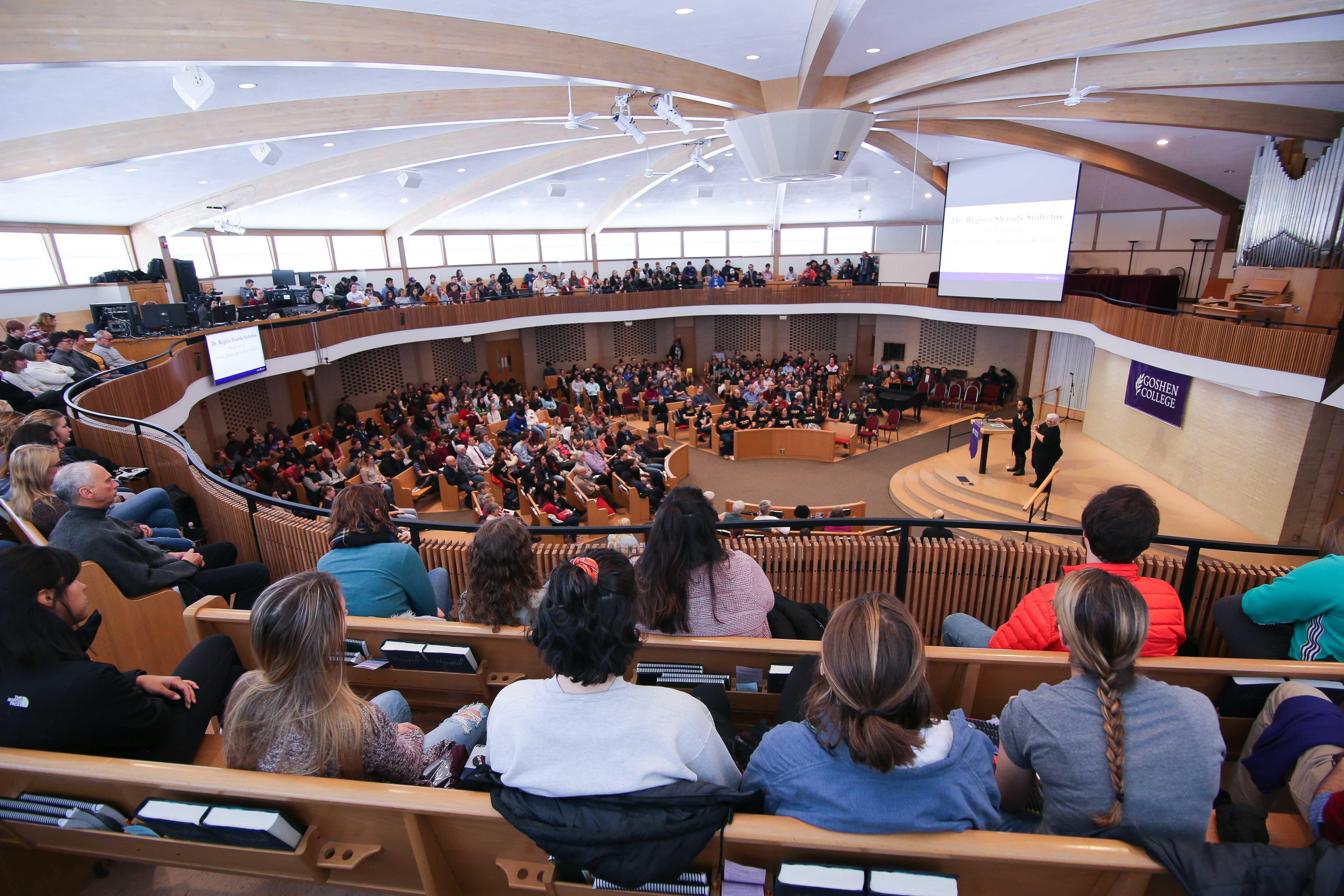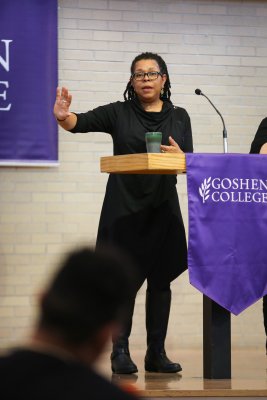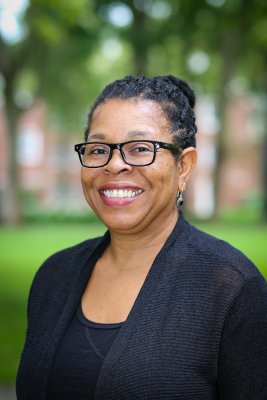Speech: Regina Shands Stoltzfus, “Unapologetically Just”
Speech as prepared by Dr. Regina Shands Stoltzfus, professor of peace, justice and conflict studies, on Monday, Jan. 20, 2020 during Goshen College’s King Celebration convocation.
→ See photos from Goshen College’s 2020 King Celebration events
We love a good hero story.
The hero archetype as it appears in the narratives we love best in movies, books, the games we play, we aspire to be that hero. We want to hear those stories, they encourage us, they model for us that impossible things can be done.
And there are two broad categories in these hero stories:
The first is the solitary figure that is born into unusual circumstances. They might experience a traumatic event that leads them on a quest – the thing that must be done. Or they might have a special weapon only they can wield, they hold the power that no one else has (or some other supernatural power of some kind).
There is also is the everyday hero:
An ordinary person who is met with extraordinary circumstances over which they masterfully prevail – and we find out they are not so ordinary after all.
We love a good hero story, and we love a good hero.
And while there are indeed stories of real heroes, real live people who do extraordinary things, we do not do ourselves favors by mythologizing those people, making them otherworldly. According to the archetype, that’s what a hero is – someone who does the impossible. Someone who is able to commit feats of magnificence, things that we regular folk can’t do. That’s what a hero is.
You are probably familiar with one of the biggest stories of our time – the story of the Montgomery bus boycott, the series of events that launched the civil rights career of Dr. King. The success of the boycott is one of the biggest movement success stories of the 20th century, if not the biggest. I don’t make light of it at all and when I talk about it being mythologized, what I mean that it is truncated so severely that we miss the power of the big story.
Rosa Parks was a tired African American seamstress who one day refused to give up her seat on a bus in Montgomery, Alabama to a white man. By doing so, she bravely, accidentally and single handedly launched the civil rights movement which eventually prevailed. How very impossible for someone like me to emulate. I wouldn’t know how to comport myself. I’m not that brave.
Even if you know the more accurate version of the story, the elongated version, it’s still useful to think about how many of the 65 years since that fateful day we have hung on to this simplistic yet dramatic narrative.

The real deal
Rosa McCauley Parks was a well read, conscious, activist person who came from an activist family. Her own definition of herself was as a rebellious person. The circumstances around her helped shape this sense of rebelliousness.
Born in 1913, she was the grandchild of enslaved people, her grandfather was the slave owner’s son. The women in her family in particular – her mother and her grandmother – raised her to not think of herself as inferior to any person. As a child, she witnessed the escalation of Klan violence after WWI. She would have been six years old during what was called the Red Summer of 1919 when Black soldiers returned from war, expecting that they had now earned the right to be treated as equal Americans. In her town churches were burned and black people were whipped and killed, found dead in the streets.
She was an early and avid reader, and was raised on the notion that a primary goal of education was learning and claiming the history of black resistance.
Jeanne Theoharis, author of a wonderful biography on Parks, explained how Rosa’s consciousness developed not only from events happening in the world, but in how her family talked about it. She writes: (“The Rebellious Life of Mrs. Rosa Parks” )
At home, the McCauleys discussed the history of slavery, the situation of blacks in Alabama, and how “to survive, not getting into trouble by confrontation with white people who were not friendly to us”. Rosa’s family sought to teach her a controlled anger, a survival strategy that balanced compliance and militancy. One of the lessons her mother imparted that lodged in Rosa’s head was how “slaves had to fool the white people into thinking that they were happy. The white people would get angry if the slaves acted unhappy. They would also treat the slaves better if they thought the slaves liked white people.” As she became aware of the terms of white supremacy, the fact that acting happy produced better treatment stuck in her throat. She longed for ways to contest this treatment. She also well understood the punishment for resistance.”

Parks would constantly have to battle these two forces: militancy could get a person killed and yet resistance, however dangerous, pushed back on the oppression and at times made it diminish.
While there are more stories about her childhood and teen years that help us know this woman, I’ll fast forward ahead to her adult years.
Unsurprisingly, Parks became an organizer and investigator for the Montgomery NAACP. In the 1940s Parks used her passion for justice to investigate incidents of sexual assault against black women, something that law enforcement systemically ignored.
In the summer of 1955, when she was 42 years old, Parks spent two weeks at the Highlander Folk School in Tennessee. The Highlander school was a place for black and white activists to train, to plan. At this point, Parks had been an organizer for years, but was down over what seemed like little to no change. For two weeks at the Center, she worked at plans for desegregating schools, but didn’t have much hope for any kind of change in Montgomery.
And then there was the bus.
But before we get to the details of that fateful day, let’s make sure we are really clear on how segregation of public transportation actually functioned. The front half of the bus was reserved for white riders, the back for African Americans. However, if all of the seats in the front of the bus, in the white section, were full, it was incumbent upon black riders to give up their seats for white riders.
Furthermore, the segregated buses served as a daily reminder for its riders, the citizens of Montgomery, of the racial hierarchy in operation. Buses had 2 doors; one in the front and one in the back. Some of the drivers would require their black passengers to enter the front of the bus to pay their fare, get off the bus and walk around to the back and enter through the rear door. The message was clear as bus riders day after day embodied their status by literally ritualizing what was for many a twice daily bus ride.
And so we finally come to December 1, 1955. Parks refused to give up her seat for a white man, the third African American woman within a year to do so. Like the other women before her, she was arrested. The next day, the Women’s Political Council, which had been strategizing for over a year about the buses, called for a one-day boycott.
As people began to mobilize, the 26-year-old pastor of Dexter Avenue Baptist Church, Martin King, is elected as the president of the newly formed Montgomery Improvement Association.
The boycott lasted for 380 days. It was a win, with the federal district court eventually declaring segregation unconstitutional and the supreme court upholding the decision.
The irony of the situation is by the time of the mass meetings to organize the boycott after Parks arrest, her voice was diminished. Many of the participants of the CRM have acknowledged much of the visible leadership, including whose voices were heard at the gatherings and those who spoke for the movement were often the men. But the women were there. And young people were there. Ordinary people, scores of ordinary people made the bus boycott a success.
And this is the genius of movements; they are made of people. There is no lone superstar that singlehandedly pulled this campaign off. It is so important for us to remember this as we face the work for our own time. What I love about this long, expanded story is that it epitomizes this year’s theme: unapologetically just. Rooted in the way of Jesus.
James Cone, the architect of Black liberation theology, in a lecture at Princeton Theological Seminary titled: The Relationship of the Christian Faith to Political Praxis” noted:
For liberation theologians… faith and praxis (praxis is ‘doing’) belong together, because faith can only be expressed in a political commitment to the humanization of society. We believe that inherent in faith is the love of God. And the latter can only be manifested in the love of one’s neighbor. Therefore (Gustavo) Gutierrez writes, ‘To know God is to do justice.’ He continues, ‘It is not enough to say that the love of God is inseparable from the love of one’s neighbor. It must be added that the love of God is unavoidably expressed through the love of one’s neighbor.’”
And it is for this reason this year’s theme is “unapologetically just.”
Justice is about right relationships. Relationships with each other, with the earth, with the creator.
Our current social climate reality calls for – demands – an active reinterpretation of faith for the present context.
Battles we thought were long won lay unfinished, ground we though we gained rolled back. So what do we do in the meantime? What is the strategy?
At the end of the day justice calls. From where you sit, in the day to day comings and goings, what does it look like. In your discipline, what does it look like? Clean water? Access to education? A safe home? A safe campus?
Dr. King talked about the triple evils of racism, poverty and militarism. He said that these three entities are interrelated. They keep us, all of us, from realizing what he called “The Beloved Community.” King adopted the term, first used by theologian Josiah Royce, to mean something that was actually attainable. Put simply, it is the idea that all people can get along, and share the wealth of the earth. But it would take work. It would take skills. It would take, at the very least, the acknowledgement of our common humanity and our need for one another.
Sandhya Jha (Pre-post Racial America: Spiritual Stories from the Front Lines) and the director of the Oakland (CA) Peace Center says:
A critical first step in building the Beloved Community is making sure no one has to be in perpetual fear for their lives. I think we sometimes overlook this step because we take it for granted… and while we continue to address that first step, maybe the next step is making sure everyone has some reason to hope for the future.”
She says further:
If we don’t find a way to listen to one another’s stories across difference, recognizing that even within racial/ethnic groups we have a broad array of experiences that we need to honor, we will keep rebuilding the foundations of the Beloved Community over and over again. Because those of us building it will get so frustrated at being ignored or villainized or homogenized that we’ll take a sledgehammer to the unstable foundations and have to start from scratch.”
Perhaps, friends, the Beloved Community best begins in small ways. In sanctuaries. In classrooms. On dorm floors and in office suites. In the places we find ourselves living our regular, daily lives. Perhaps for us too, feats of extraordinary courage that break open that which we thought was unbreakable begins with small moments: paying attention to the world around us. Talking about it with our loved ones. Learning more by consciously seeking others with varying vantage points and different life stories. Being connected to, and grounded in communities that are unafraid to name injustice over and over again.
Beginning in small ways, yes, but refusing to stay small. Coordinating 380 days of alternative transportation, after all, is not small.
We don’t revisit these stories to rest upon days gone by, in the same way that we don’t abandon our faith narratives after we have heard them once. We tell these stories, the real, complicated human versions of them, to celebrate them, yes. But also to equip us for the now. The threats of racism, poverty and war are still with us. The work is not done.
The work of liberation is not done in isolation. It is not done absent of community. It does not happen without being informed, and without the realization of how oppressions are connected.
And at the end of the day, being fiercely unapologetic about claiming justice for ourselves, for each other, and for all in the Beloved Community.
May it be so. May it ever be so.
About Dr. Regina Shands Stoltzfus

Dr. Regina Shands Stoltzfus began teaching at Goshen College in 2002 and teaches courses in race, class and ethnic relations; personal violence and healing; peacemaking; women and gender studies; biblical studies; and transforming conflict and violence. She attended Goshen College and earned a bachelor’s degree in English from Cleveland State University in 1988. In 2001, she earned a master’s degree in biblical studies from Ashland Theological Seminary and a Ph.D. in theology, ethics and contemporary culture from Chicago Theological Seminary.
Shands Stoltzfus previously served as an associate pastor at Lee Heights Community Church in Cleveland, Ohio, as campus pastor at Goshen College, as minister of urban ministries with Mennonite Mission Network, as staff associate for urban peacemaking with Mennonite Conciliation Service and as director of admissions at Anabaptist Mennonite Biblical Seminary. She is a co-founder of the Damascus Road anti-racism education program, now called Roots of Justice Anti-Oppression program, and regularly leads anti-racism workshops. She serves on the steering committee for the Women in Leadership Project and on the Panel on Sexual Abuse Prevention with Mennonite Church USA. She co-authored the book “Set Free: A Journey Toward Solidarity Against Racism” (Herald Press, 2001). She is an active writer for The Mennonite, Sojourners and other print and online publications.
In 2016, Shands Stoltzfus was awarded the State of Indiana Civil Rights Commission’s (ICRC) Spirit of Justice Award, the commission’s highest honor.




